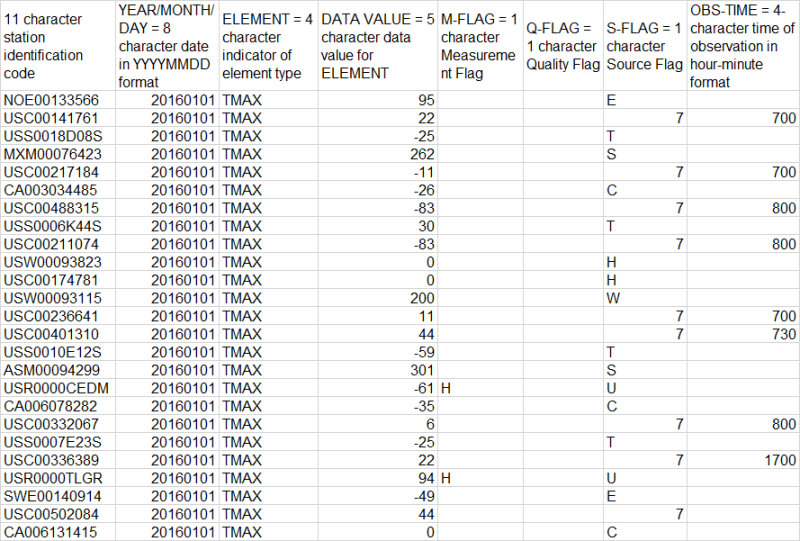"maybe we don't have "data", just a number of numbers ?
Not sure what you mean; the data are labeled as TMAX, other fields not included in the screencap are TMIN, TOBS (which is what I should have filtered for) etc.:
ELEMENT is the element type. There are five core elements as well as a number
of addition elements.
The five core elements are:
PRCP = Precipitation (tenths of mm)
SNOW = Snowfall (mm)
SNWD = Snow depth (mm)
TMAX = Maximum temperature (tenths of degrees C)
TMIN = Minimum temperature (tenths of degrees C)
The other elements are:
ACMC = Average cloudiness midnight to midnight from 30-second
ceilometer data (percent)
ACMH = Average cloudiness midnight to midnight from
manual observations (percent)
ACSC = Average cloudiness sunrise to sunset from 30-second
ceilometer data (percent)
ACSH = Average cloudiness sunrise to sunset from manual
observations (percent)
AWDR = Average daily wind direction (degrees)
AWND = Average daily wind speed (tenths of meters per second)
DAEV = Number of days included in the multiday evaporation
total (MDEV)
DAPR = Number of days included in the multiday precipiation
total (MDPR)
DASF = Number of days included in the multiday snowfall
total (MDSF)
DATN = Number of days included in the multiday minimum temperature
(MDTN)
DATX = Number of days included in the multiday maximum temperature
(MDTX)
DAWM = Number of days included in the multiday wind movement
(MDWM)
DWPR = Number of days with non-zero precipitation included in
multiday precipitation total (MDPR)
EVAP = Evaporation of water from evaporation pan (tenths of mm)
FMTM = Time of fastest mile or fastest 1-minute wind
(hours and minutes, i.e., HHMM)
FRGB = Base of frozen ground layer (cm)
FRGT = Top of frozen ground layer (cm)
FRTH = Thickness of frozen ground layer (cm)
GAHT = Difference between river and gauge height (cm)
MDEV = Multiday evaporation total (tenths of mm; use with DAEV)
MDPR = Multiday precipitation total (tenths of mm; use with DAPR and
DWPR, if available)
MDSF = Multiday snowfall total
MDTN = Multiday minimum temperature (tenths of degrees C; use with
DATN)
MDTX = Multiday maximum temperature (tenths of degress C; use with
DATX)
MDWM = Multiday wind movement (km)
MNPN = Daily minimum temperature of water in an evaporation pan
(tenths of degrees C)
MXPN = Daily maximum temperature of water in an evaporation pan
(tenths of degrees C)
PGTM = Peak gust time (hours and minutes, i.e., HHMM)
PSUN = Daily percent of possible sunshine (percent)
SN*# = Minimum soil temperature (tenths of degrees C)
where * corresponds to a code
for ground cover and # corresponds to a code for soil
depth.
Ground cover codes include the following:
0 = unknown
1 = grass
2 = fallow
3 = bare ground
4 = brome grass
5 = sod
6 = straw multch
7 = grass muck
8 = bare muck
Depth codes include the following:
1 = 5 cm
2 = 10 cm
3 = 20 cm
4 = 50 cm
5 = 100 cm
6 = 150 cm
7 = 180 cm
SX*# = Maximum soil temperature (tenths of degrees C)
where * corresponds to a code for ground cover
and # corresponds to a code for soil depth.
See SN*# for ground cover and depth codes.
TAVG = Average temperature (tenths of degrees C)
[Note that TAVG from source 'S' corresponds
to an average for the period ending at
2400 UTC rather than local midnight]
THIC = Thickness of ice on water (tenths of mm)
TOBS = Temperature at the time of observation (tenths of degrees C)
TSUN = Daily total sunshine (minutes)
WDF1 = Direction of fastest 1-minute wind (degrees)
WDF2 = Direction of fastest 2-minute wind (degrees)
WDF5 = Direction of fastest 5-second wind (degrees)
WDFG = Direction of peak wind gust (degrees)
WDFI = Direction of highest instantaneous wind (degrees)
WDFM = Fastest mile wind direction (degrees)
WDMV = 24-hour wind movement (km)
WESD = Water equivalent of snow on the ground (tenths of mm)
WESF = Water equivalent of snowfall (tenths of mm)
WSF1 = Fastest 1-minute wind speed (tenths of meters per second)
WSF2 = Fastest 2-minute wind speed (tenths of meters per second)
WSF5 = Fastest 5-second wind speed (tenths of meters per second)
WSFG = Peak gust wind speed (tenths of meters per second)
WSFI = Highest instantaneous wind speed (tenths of meters per second)
WSFM = Fastest mile wind speed (tenths of meters per second)
WT** = Weather Type where ** has one of the following values:
01 = Fog, ice fog, or freezing fog (may include heavy fog)
02 = Heavy fog or heaving freezing fog (not always
distinquished from fog)
03 = Thunder
04 = Ice pellets, sleet, snow pellets, or small hail
05 = Hail (may include small hail)
06 = Glaze or rime
07 = Dust, volcanic ash, blowing dust, blowing sand, or
blowing obstruction
08 = Smoke or haze
09 = Blowing or drifting snow
10 = Tornado, waterspout, or funnel cloud
11 = High or damaging winds
12 = Blowing spray
13 = Mist
14 = Drizzle
15 = Freezing drizzle
16 = Rain (may include freezing rain, drizzle, and
freezing drizzle)
17 = Freezing rain
18 = Snow, snow pellets, snow grains, or ice crystals
19 = Unknown source of precipitation
21 = Ground fog
22 = Ice fog or freezing fog
WV** = Weather in the Vicinity where ** has one of the following
values:
01 = Fog, ice fog, or freezing fog (may include heavy fog)
03 = Thunder
07 = Ash, dust, sand, or other blowing obstruction
18 = Snow or ice crystals
20 = Rain or snow shower
TTFN (ta ta for now)
I can do absolutely anything. I'm an expert!
faq731-376 forum1529


